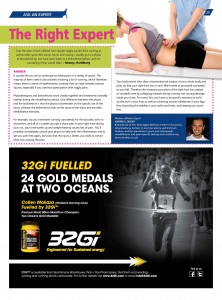The Right Expert
Posted on September 5th, 2012 by Andries Lodder

Modern Athlete Magazine September Issue: Ask an Expert
Over the years I have suffered from regular niggly injuries from running as well as other sports like soccer, tennis and rowing. I usually go to a Physio to be patched up, but have never been to a Biokineticist before, and am wondering if that would help? – Sue, Randburg
Answer
It seems like you are an active person taking part in a variety of sports. The majority of them seem to be activities involving a lot of running, therefore there’s a sense of repetitiveness involved with all of the above sports that can lead towards overuse injuries, especially if you continue participation with niggly pains. However there could be many reasons for injuring yourself, so going to a Physio first is always a good place to start your recovery process.
Physiotherapists and Biokineticists work closely together and treatments normally overlap during the rehabilitation period. One difference between the Physio and the Biokineticist is that the Physio concentrates on the specific site of the injury, where as the Biokineticist looks at the cause of the injury and provides rehabilitative exercises to correct it.
To clarify the issue further by use of an example, say you have been running consistently for the last year with no discomfort, and all of a sudden you get a sharp pain in your right knee during your run. Your knee swells up and weight bearing causes lots of pain, you would need to immediately consult your Physio to help with the swelling and inflammation and to get you pain free. Now that the injury is better, you need to correct what was causing the pain. Your Biokineticist does a biomechanical analysis of your whole body and picks up that your right foot has no arch (flat footed or pronated) compared to your left. Therefore the excessive pronation of the right foot has created an unstable knee by collapsing inwards during running and causing damage inside your knee. To correct this you have to do specific exercises to build up the arch in your foot as well as correcting muscle imbalances in your legs. Thus improving the stability in your ankle and knee and keeping you injury free.
www.modernathlete.co.za
Tweet
